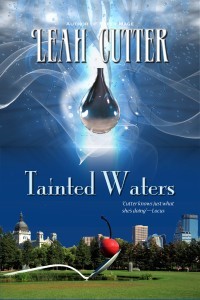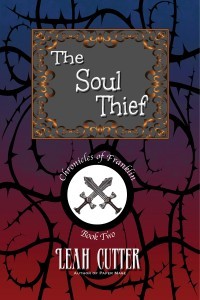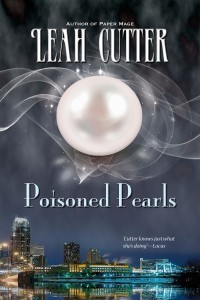Leah R. Cutter's Blog, page 10
June 4, 2015
Only 6 hours to go….
Before The Write Stuff story bundle disappears.
In other news – waiting for contracts, so there will be more NEWS soon.
Am roasting coffee this afternoon – the last of the mystery beans. It’s made nice coffe, but nothing memorable. Am trying a Brazilian bean next.
Crossposted from my website. If you'd like to comment, you can do so here or there.
June 3, 2015
One Last Day…
One last day before The Write Stuff story bundle will be no more!
I mean, the individual books will still be available. But you won’t be able to buy them all together for one amazingly low price!
If you’ve been considering investing in this bundle, I would do so now, rather than later, before this deal completely disappears.
And in the meanwhile, have this photo of some of the beautiful roses in my backyard. They, too, will be gone shortly.

Crossposted from my website. If you'd like to comment, you can do so here or there.
May 30, 2015
Thank yous

First of all, I’d like to say a big THANK YOU to all of those who participated in the Goodreads giveaway of Tainted Waters. All the copies are now in the mail. The US people should get theirs mid-June, the international folks mid-July. Possibly sooner, but I’m not going to guarantee it.
Of course, if you didn’t win, it’s still available from your favorite retailers.

My next big THANK YOU goes out to all of you who have purchased The Write Stuff story bundle! I sincerely appreciate the support.
The story bundle will only be available for a few more days, so if you want a copy, you should go get one sooner rather than later.

And last but by far, not least, a HUGE THANK YOU to all my readers. I sincerely appreciate every single one of you. I have more books coming out this year that I hope delight you and entertain you. There’s probably yet one more business book as well, though this one will deal with running a vacation rental.
Crossposted from my website. If you'd like to comment, you can do so here or there.
May 28, 2015
BFB V2, Chapter Six: The Schedule is Written in Pencil
The following is a chapter from Business for Breakfast, Volume 2: The Beginning Professional Publisher.
The ebook is available from Amazon, Kobo Books, Barnes & Noble, iBookstore, and the paper version is available from Createspace.
However, if you’re like most publisher (unwilling to spend money unless absolutely necessary) I will also be posting a chapter a week, so you’ll merely have to have patience to read all twelve chapters.
Did you know that the first book in this series, Business for Breakfast, Volume 1: The Beginning Professional Writer is currently available as part of a Storybundle!?!?!? It is! There are so many fabulous books in the bundle about the business and craft of writing. Check it out.
Chapter Six
The Production Schedule is Written in Pencil
A production schedule should be developed for every project. This way, you’ll have a good idea of what you’re publishing and when.
But where does a production schedule start? Where does it end? And what are all the steps between manuscript and finished project?
I’m going to start with the finished project and move forward, accumulating dates. You can, however, move backwards: Pick a date by which you want to have something published, then work backwards figuring out your dates. I wouldn’t advise doing this unless you have a lot of lead time, or are already familiar enough with your publishing schedule that you know where you can fudge things.
This chapter is going to get into more of the details of publishing, as well as building your own Checklist O’Doom.
Production—The Start
When does a book go into the production process? That’s something that you’ll get to decide for yourself.
Some publishers start with the beta or first reader. The writer has done their best to write a great book. Now it’s time for an outside reader to point out where they got confused, where they cheered for the villain, where they laughed out loud, and perhaps where they started cursing the writer because it was two o’clock in the morning and they couldn’t put the damned book down.
NOTE: I am NOT advising you to send your work to a critique group. See Business for Breakfast, Volume 1, ”Chapter Seven, Self–Confidence 101“ for the differences between critique and first readering.
For novels, I generally allow two months for the first reader phase: One month for the readers to read, and a second month for me to think about things and incorporate comments.
It generally doesn’t take me that long to incorporate comments. But sometimes other projects are in the way, and I can’t get to the comments immediately. Two months gives me a good cushion.
You get to decide what’s right for your business and process. Maybe the whole first reader step only takes a month—readers get two weeks and the writer gets two weeks.
But mark those dates down, as well as add first reader to your checklist.
Copyedits
I try to always send everything I write to a copyeditor. I have misspelled my own name before. I mix up words like “lie” and “lay,” “further” and “farther.” I need a good copyeditor to go through and clean up things.
Good copyeditors are busy people. This is another reason why I tend to give the first reading process two months: I can then give the copyeditor a firm date two months out for when I will need her services.
I can’t just expect to finish something and drop it on her desk. She also has a very long lead time and schedule.
What if your favorite copyeditor isn’t available in two months? He’s gotten so popular that now he needs four months lead time?
Then you have a business decision to make. Do you continue to use this copyeditor, and adjust your publishing schedule? Or do you ask for suggestions and find another?
This is part of why the publishing schedule is always written in pencil.
As a publisher, I’ve developed relationships with three different copyeditors: my main two, plus a backup. If you’re sending a lot of material out, you might consider doing the same.
Add send to copyeditor to your checklist.
How long do your copyedits generally take? I write fairly clean copy. By the time it goes to the copyeditor there really aren’t that many mistakes for her to correct. So I get my material back in two weeks or less.
Another date to add to your calendar, another copyedits returned to add to your checklist.
How long will it take you to incorporate the copyedits? Again, since I write fairly clean copy, I generally give myself two days. It takes that long for me in part because I’m trying to learn: I look at every comment and figure out why it’s there, what it was she fixed, so the next time, I won’t do it again.
How long it takes your writer is really going to depend on you, your process, and the particular project.
Yet another date to add to your calendar, as well as adding incorporate copyedits to your checklist.
Covers
Perhaps while you’re waiting for your first readers to get back to you, you can create your cover or covers. Or maybe you’ll create your covers while the book is with the copyeditor.
Or perhaps you’re hiring out, having someone else create the covers for you.
However your covers get created, you need to have them finished before you can start formatting your book.
Add create covers to your checklist.
I’m a member of a publishing cooperative, Book View Café. One of the wonderful things about being a member is that I can post the covers I design to the forums there and get critique and commentary from other professionals.
This cover review is also something I build into my schedule, generally about a weeks’ worth of back and forth. If someone else is creating your cover, make sure you build review time into the schedule.
You may want to form your own group of professionals for critiquing covers. I would suggest putting up a cover (regardless of who created it) and merely asking, “What genre is this book?” Until you really know genre, the answers may surprise you. Keep trying. Keep learning.
Add cover review to your checklist.
Different platforms take different cover sizes. Facebook prefers a particular image size. Amazon takes another. You may develop your own specific cover size for your website. And you may decide to do a smaller cover for inclusion in your ebooks.
NOTE: The different websites may or may not require a different size. They’ll just crop the picture for you. Therefore your final version will look odd. It’s better to learn the different sizes preferred by the different platforms and create them, so that way your covers all look the same.
Also, is this book going to be electronic only? Will you need to develop a print version? As well as an audio version? They all have their own requirements.
Add generate different cover sizes to your checklist.
Blurbs
If you’re creating a print edition of your book, you’ll need the blurb at this time, to add to the cover.
For me, it doesn’t take me that long to write the first blurb. However, I generally throw it out and end up writing a second one. Or I tighten the first one significantly. None of it takes a lot of time. I do find, though, that I iterate on blurbs, improving them every time I touch them.
So creating a blurb needs to go on your checklist. You might also want to give yourself time to iterate and improve on a blurb.
Plus, you may need to develop a short blurb, a long blurb, a book tag, etc.
Add create short blurb, long blurb, book tag, author tag to your checklist.
Formatting
This may be a process you hire out—Knotted Road Press does ebook as well as print book formatting. Or you may take the time to learn how do to it yourself.
However, it will take some time. Because I format a lot of books, and I have a technical background, it doesn’t take me that long.
Add format book to your checklist.
Print Formatting
For me, formatting a print book takes longer than creating an ebook. I allow at least half a day of solid work to do a short book, two days at least for a longer book.
It isn’t because it takes that much time to do the actual work. But I find my eyes get fuzzy if I work too long on a particular project, and I need to take breaks and go do something else for a while.
If I’m doing a print book, I automatically add six weeks to the schedule. Why?
Because you will need to view a printed proof of the book before you approve it. I am a small business, that means I want the cheapest shipping rate possible. Sometimes the service I use for print books (Createspace) can get me a proof in a week.
Sometimes, though, it takes two weeks.
Then what happens if there’s a mistake and I need to generate another proof? That’s potentially another two weeks.
I can have something called Extended Distribution via Createspace. What this means is that my paper book will automatically display in the Barnes and Noble catalog, as well as the Kobo catalog, etc. without me doing a thing.
But it takes time for the book to show up in the extended distribution catalogs.
So I tend to approve the final Createspace print two weeks or more before I publish the electronic version.
Add print formatting to your checklist, as well as uploading to distributor, and verifying printed proof.
Ebook Formatting
I have a degree in computer science, and worked in the technology field for many years. I hard–code all of the HTML and add my own CSS file when formatting an ebook.
Most people don’t do that. They use a simpler program such as Calibre or Jutoh. It is up to you what you use. But make sure that you give yourself time to do the work, as well as fix any errors.
Then look at your ebook. Look at it on your phone. On a tablet. On your boyfriend’s computer. Look at it using different computers and programs.
I believe, at this time, that Jutoh automatically verifies your epub, while Calibre doesn’t. If the software you use to create an epub doesn’t validate your epub, you should do it. I recommend uploading your epub to an epub verification site—I use the International Digital Publishing validator site (http://validator.idpf.org.)
Add format ebook to your checklist, as well as verify ebook.
Categories and Keywords
The one last piece of information you need before you start publishing are the categories and keywords for your book. Spend an hour or more determining your keywords before you start publishing.
Add determine categories and keywords to your checklist.
For more on keywords and categories, see Business for Breakfast, Volume 2, Chapter Ten, Distributing and Branding.
Price
What is the appropriate price for your book?
Believe it or not, that’s also determined by genre. In some markets, like romance, readers won’t pay a lot for their books, in part, because they read so many of them. In other markets, like mystery, readers expect to pay more for their books.
You need to spend another hour or more studying pricing for your genre.
Then add determine the price to your checklist.
Publish!
You’ve already set up all your accounts with the distributors. You’ve established your publishing date.
Now it’s time to upload your files (which are all in a single, findable place, right?) As well as enter the description (again, your blurbs are all in a single, findable place, right?) And the keywords. And the cover.
The publishing process takes time, just because it does. I generally do publishing on Saturday afternoons, so that way I’m ready to announce that the book is published on the following Tuesday.
Plus, if something goes wrong, I will have time to fix the issue before Tuesday.
Add Publish to distributors, as well as the list of distributers that you’re using on your checklist, so that you won’t miss any.
And now, you’re done! Right?
No, next comes the post–production phase, which I’ll cover in the next chapter.
In Conclusion
Here are the three things to remember about the production schedule:
The schedule can be long and complicated. Make a checklist.
The checklist includes things like copyedits, generating all the different covers, formatting, picking a price, and publishing.
Publishing to distributors is not the last step.
The ebook is available from Amazon, Kobo Books, Barnes & Noble, iBookstore, and the paper version is available from Createspace.
Storybundle!
Did you know that the first book in this series, Business for Breakfast, Volume 1: The Beginning Professional Writer is currently available as part of a Storybundle!?!?!? It is! There are so many fabulous books in the bundle about the business and craft of writing. Check it out.
Crossposted from my website. If you'd like to comment, you can do so here or there.
May 26, 2015
Tainted Waters now available!
New novel by ME!!! Tainted Waters is now available!
And it’s a sequel! (Hear the crowd go ooooooh, ahhhhhhh.) It’s another story about Cassie, my favorite, loud-mouthed lesbian, who I adore. The first is Poisoned Pearls.
Here’s the blurb:
A terrorist bomber threatens Minneapolis during the run-up to the Aquatennial. None of the Post-Cogs can get a fix on him: whenever the bomber arrives, the timelines get corrupted.
Cassie has other problems, too. No one will hire her because of how she came into her abilities. Her life of bliss with her girlfriend Sam has soured. She’s even fighting with Chinaman Joe.
When Cassie discovers that the bomber moves like Hunter, the vet who claims ghosts taught him, she’ll have to invoke the Norse gods—as well as any others who are listening—to stop the madmen determined to raise the dreaded Old Ones and create Hell on earth.
It’s available at Book View Cafe, Amazon, Kobo Books, Barnes and Noble, and as a trade paperback at Createspace.
You want to know another really cool thing? You can enter a Goodreads giveaway to win a free copy of Tainted Waters! It’s running all this week.
I hope you enjoy reading this novel as much as I enjoyed writing it.
Crossposted from my website. If you'd like to comment, you can do so here or there.
May 22, 2015
The Morning Coffee

I continue to have great fun roasting coffee beans – mad, wild experiments in SCIENCE!
The beans I did before my most recent batches were Sumatran. All the Sumatran beans I’ve ever had have always been done with a dark roast. So I tried to buck the trend and give them a lighter roast.
The results were disappointing. The beans just have a stronger flavor, naturally. The lighter roast was wasted on them, and didn’t bring out enough of the flavor. I ended up doing a darker roast with them–higher temps over a longer period of time–and got good coffee. It wouldn’t be coffee I’d have every day, but if I was having a dinner party and wanted a darker roast to go with a heavier meal, the Sumatran beans would be perfect.
Most recently, I’ve been experimenting with an Ethiopian bean. Ethiopian beans are frequently done with a lighter roast. The first batch I tried my usual recipe: Start out with a high temperature and high fan until the first crack, then lower the temperature to stretch out the time between first and second crack.
The numbers were all good, the timing right in terms of first and second crack compared to other beans I’ve done. But the coffee made from this roast was thin. I don’t know how else to describe it. Weak tasting. Even making coffee using less water didn’t help.
So I lowered the temperature at the start. Better, but not perfect.
The last batch I did with them I used a low temperature for the entire roasting process. It took longer to get to the first crack than I normally do. Then I didn’t play with the settings – just left it on low, for a shorter period of time than usual.
OMG did that make lovely coffee. Rich and tasty, without being heavy, lots of coffee flavor. Not greenness or berries. Darker flavors, maybe blackberries instead. Just yummy.
Today, I roasted my mystery beans. I bought them at my usual shop, but then I forgot to mark the bag. I have no idea what they are. They’re possibly Columbian beans. But we’ll see. We’ll see how this batch turns out.
As y’all can tell, I have great fun experimenting like this. As well as sharing what I’ve learned.
I did the same thing with the Business for Breakfast books–lots of experimenting, trying things, failing, trying new and different things, failing some more, though eventually, succeeding.
If you’d like to learn from some of my mad experiments, Business for Breakfast, Volume 1: The Beginning Professional Writer is part of this fantastic story bundle that will only be available for a short period of time. The books are all focused on the craft and business of writing, all from professionals who have been in the trenches and have had their own share of failure and success.
The bundle won’t be around for too long, so go and get it while you can!
Crossposted from my website. If you'd like to comment, you can do so here or there.
May 21, 2015
Throwback Thursday, BFB Style
In the spirit of “Throwback Thursdays” – I’m repeating a Business for Breakfast post. Namely, Chapter 12, Practice, from Business For Breakfast, Volume 1: The Beginning Professional Writer.
Part of why I’m doing this is to give you a sample and possibly to entice you to go look at the Storybundle that this book is part of. The bundle is only available for a limited time, so if you’re thinking about getting it, you should do it sooner, rather than later.
Chapter Twelve
Practice
One of the greatest concepts that was ever shared with me by Dean Wesley Smith was the idea of practice.
It’s head–scratching that I wasn’t practicing before Dean said something about it. It made sense to me the moment he started talking about.
I think it’s one of the best tools in a professional writer’s tool box.
This chapter discusses practice, the hows and whys.
What Do You Mean, Practice?
In every art, there’s a certain level of practice involved. You try something new. You experiment with it. You try it again. Then you do it some more.
For example, the first time you sat down with a sketchpad and pencil, did you just start drawing everything that was around you? No. You started with simple shapes and moved onto more complicated figures.
You might draw pages and pages of eyes, trying to get the expression just right, perfect the shape, figure out how to make the eyelid look realistic.
Then you move onto noses, and do the same thing. Over and over again.
Writing is the same way. You keep trying something, over and over, until you get good at it.
That Next Level
One of the things that I love about writing is that there’s always something new to learn. A new technique. A new way of describing something. A new voice to experiment with.
Do I always succeed when I go swinging for the fences? Heck no. I have stories that are completely broken, that will never see the light of day because they’re so unrepairable. Whole novels, in fact.
But that doesn’t stop me from trying.
No matter how good you get, you should always be growing as an artist.
If you stop growing, chances are you’ll also stop selling. Maybe not right away. But your work will no longer be fresh, alive, vibrant. And that will show. You’re phoning it in.
The greatest writers of our time, the most successful, are still practicing. Still experimenting. They aren’t doing the same thing over and over again.
As a reader, you know when a writer has stopped trying.
Don’t be that guy.
Keep reaching for the new heights.
How
Perhaps I’ve convinced you that you should practice.
The next question, of course, is how.
Every writer is going to be different in how they approach this. I can only tell you my method. You’ll need to adapt it for your own work.
I primarily practice in novels, not short stories. (Though sometimes I go pretty far off the rails with an experimental short story.)
I will pick some aspect of storytelling that I want to practice for a particular novel. I have a reminder board on my door that I write things on. Generally, I’ll write whatever I’m practicing on that board, so I’ll see it every day.
The practice for this book? Small bites.
A lot of the topics in this book are large, sprawling, and interconnected.
I practiced taking small bites. Breaking things up. Not just ideas, but sentences. Sections.
Keep everything bite–sized, so it’ll be easy to swallow, digest, and learn.
For the novels, I’ve had a lot of different practices. For example, for more than one novel I’ve practiced cliffhangers—that is, how to end a scene or chapter with a bang, pushing the reader forward. For other novels, I’ve practiced Voice. I write voicey things. I’ve practice Voice, to make sure that a piece has a clear, distinct, possibly over–the–top voice.
But then I discovered that I sacrificed other things when I focused so much on Voice. So I wrote a novel where the practice was Voice with Setting.
I’ve also practiced being weird, going over the top, making non–sympathetic characters understandable enough that the reader didn’t mind them, and so on.
There are so many things you can practice.
The project I’m working on will suggest the practice. Then I just remind myself, before I start writing, of what my practice is. I let my back brain take care of the rest.
The Joy of Practice
As I’ve mentioned before, I giggle—a lot—when I’m writing fiction.
What I’ve discovered is that I’m generally practicing the thing that makes me giggle. For example, I recently had a novel where my board read, “Dare to be weird.”
I discovered that every time I stopped giggling, it was because I’d gone normal. I’d done the expected thing.
I needed to go back, throw away what I’d written, and go weird. Go big. Go strange.
My practice is intimately tied to my enjoyment of a piece. If I’m doing my practice well, I know the work is good, too.
What to Practice
I read for enjoyment. I don’t just read to do research. I’m right now reading a lot of modern poetry.
I know a lot of writers who don’t read for enjoyment—either the other words coming in messes them up, or they can’t turn off their critical brain, or what have you.
I think it’s important to be able to read for enjoyment. It’s part of that whole, “I want to learn new techniques.”
You might think that’s a contradiction—how can I read for enjoyment while at the same time learning?
This is where Jack comes in.
Remember—writer here. Lots of different people in my head.
I picture Jack as a Jack Russell Terrier. He sits, patiently nosing along, while I read for fun.
His job? Point out the unusual.
I’ll be reading along and suddenly Jack will jump up, trying to get my attention. There will be something different about what I just read, something he hasn’t seen before. For example, in The Queen’s Gambit by Walter Tevis, mostly Jack just went along for the ride until the very last chapter, midway through the climax.
Took me a while to realize that the entire book had been written using a particular sentence structure, but that right there, for those two paragraphs, the sentence structure had changed.
It was masterfully done.
Will I ever practice that? Perhaps. Maybe try it first in a short story.
It’s amazing the things that Jack points out. And he enables me to be able to relax enough to enjoy reading.
So this is one of the ways I figure out what to practice. By reading for enjoyment, and finding new techniques.
Judging Your Practice
When can a writer accurately judge whether a piece is successful or not?
Trick question.
A writer can never tell. Only readers know.
As I said, I’ve experimented and failed. But it was good practice. I didn’t “waste” that time. I learned something.
Remember, the only way to fail is to not try.
Do you let your “failed” experiments and practice out into the public?
If your first reader says you should.
I have a couple of stories that I feel as though I failed with—I didn’t achieve what I was trying for. I was practicing and it’s obvious, to me, that I didn’t make it. I didn’t reach what I wanted to reach.
These are some of the stories that sell the best.
I cannot judge my own work. I have to let my first reader, and readers in general, tell me if I succeeded or not.
So practice. Write and release, if your first reader thinks you can. Repeat.
In Conclusion
Here are the three things you should remember about practicing:
All art requires practice. Writing is no different.
You can practice anything. Voice. Character. Setting. Weirdness. Small bites. Whatever you want to get better at for that particular work.
Let your first reader judge whether you’ve succeeded or not.
Did you know that Business for Breakfast, Volume 1: The Beginning Professional Writer is currently available as part of a Storybundle!?!?!? It is! There are so many fabulous books in the bundle about the business of writing. Check it out.
Business for Breakfast, Volume 1: The Beginning Professional Writer, is also available from Amazon, Kobo Books, Barnes & Noble, iBookstore, and the paper version is available from Createspace.
Crossposted from my website. If you'd like to comment, you can do so here or there.
May 19, 2015
The Soul Thief available for pre-order!

WOO and HOO, y’all!
One of my favoritest books is The Popcorn Thief.
For the longest time, I thought that Franklin was just a one-off. That there wasn’t a second novel.
But Franklin started talking to me after a bit. Told me that there was more of his story, if I’d just shut up and listen for a bit.
I’m so glad I did.
The blurb for The Soul Thief:
Ghosts get stuck sometimes.
Franklin sees it as his duty to help them along, get them to pass from this earth to the Beyond.
But some ghosts start returning. Haunting Franklin. Destroying his crops.
Franklin learns he must use an ancient, powerful blade to force the ghosts back Beyond.
However, someone else wants that blade, for purposes that involve life and death, not just for the ghosts, but for all the living as well.
The Soul Thief will be generally available June 30th. For now, you can preorder your copy from Amazon, Kobo Books, and iBooks.
If you’d like a real bargain, I’m still participating in The Write Stuff story bundle. The bundle won’t be around forever, so go check it out!
[Error: Irreparable invalid markup ('<img [...] </a>') in entry. Owner must fix manually. Raw contents below.]
<p><img src="http://www.leahcutter.com/wp-content/..." alt="The Soul Thief" width="200" height="300" class="aligncenter size-medium wp-image-3235" /></p>
<p>WOO and HOO, y’all!</p>
<p>One of my favoritest books is <a href="http://www.knottedroadpress.com/wpcpr... Popcorn Thief.</i></a></p>
<p>For the longest time, I thought that Franklin was just a one-off. That there wasn’t a second novel. </p>
<p>But Franklin started talking to me after a bit. Told me that there was more of his story, if I’d just shut up and listen for a bit. </p>
<p>I’m so glad I did. </p>
<p>The blurb for <i>The Soul Thief</i>:</p>
<p>Ghosts get stuck sometimes. </p>
<p>Franklin sees it as his duty to help them along, get them to pass from this earth to the Beyond. </p>
<p>But some ghosts start returning. Haunting Franklin. Destroying his crops. </p>
<p>Franklin learns he must use an ancient, powerful blade to force the ghosts back Beyond. </p>
<p>However, someone else wants that blade, for purposes that involve life and death, not just for the ghosts, but for all the living as well.</p>
<p><i>The Soul Thief</i> will be generally available June 30th. For now, you can preorder your copy from <a href="http://amzn.to/1AbJnqI">Amazo..., <a href="https://store.kobobooks.com/en-US/ebo... Books</a>, and <a href="https://itunes.apple.com/us/book/the-...
<p>If you’d like a <i>real</i> bargain, I’m still participating in <a href="https://www.storybundle.com/writing&q... Write Stuff</a> story bundle. The bundle won’t be around forever, so go check it out! </p>
<p><a href="https://www.storybundle.com/writing&q... src="http://www.leahcutter.com/wp-content/..." alt="All Covers Jutoh Large" width="300" height="155" class="aligncenter size-medium wp-image-3294" </a>/></p>
<small>Crossposted from <a href="http://www.leahcutter.com">my website</a>. If you'd like to comment, you can do so here or <a href="http://www.leahcutter.com/blog/"...
May 14, 2015
Goodreads Giveaway ends today!
The Goodreads giveaway of Poisoned Pearls ends tonight at midnight!
Thank you so much to everyone who has already signed up! I really appreciate it.
Is this the last giveaway for this series? Heck no. Coming soon…

Crossposted from my website. If you'd like to comment, you can do so here or there.
May 13, 2015
Story bundle!
OMG you guys! YES! I have been invited to be part of a story bundle! (I TOLD you there was NEWS coming!)
Ah-hem.
Okay, pulling it together and trying to be professional about this. It is, after all, a bundle not just about the craft of writing, but the business of it.
The Write Stuff Bundle
Curated by Kristine Kathryn Rucsh
As Kris says in her note about the bundle, “…instead of focusing strictly on craft, I decided to treat this bundle like a nonfiction writing anthology. The bundle touches on everything you need to write and to have a career in writing.”
So the first of my Business for Breakfast books, Business for Breakfast, Volume 1: The Beginning Professional Writer is here.
There are wonderful book about the craft, from Dean Wesley Smith, Jerrold Mundis, Vonda McIntrye, and Judith Tarr.
There are books about the different forms your writing can take. For short stories, there isn’t a better book about the market hands-down than the one from Douglas Smith. Bob Mayer does the same thing for novels. Then J. Daniel Sawyer gives you everything you need to know about audio and podcasts.
Then there are books about the writing life, from Chuck Wendig to Laura Resnick and even Kristine Kathryn Rusch.
PLUS. (I know! That’s already so much!) The folks at Juntoh have contributed a 40% off coupon for their software (use it for creating your own epubs).
In the words of Kris:
So here it is: Everything you need to know to write what you want, how you want to write it, what to do with it when you’re done, and how to survive the perils and pitfalls of a writing career.
We pretty much covered it all in one neat bundle. If I could tie it with a bow, I would.
The initial titles in the bundle (minimum $5 to purchase) are:
The Novel Writer’s Toolkit by Bob Mayer
Writing Into the Dark by Dean Wesley Smith
Playing the Short Game by Douglas Smith
Making Tracks – A Writer’s Guide to Audiobooks by J. Daniel Sawyer
Rejection, Romance & Royalties by Laura Resnick
Business For Breakfast – Vol 1: The Beginning Professional Writer by Leah Cutter
If you pay more than the bonus price of just $15, you’ll get another five books, plus a very special code for 40% off Jutoh, an indispensable book creation tool for all platforms!
Break Writer’s Block Now! by Jerrold Mundis
Writing Horses – The Fine Art of Getting It Right by Judith Tarr
The Write Attitude by Kristine Kathryn Rusch
Pitfalls of Writing Fantasy by Vonda N. McIntyre
30 Days in the Word Mines by Chuck Wendig
40% Discount Code! by Jutoh – get 40% off your Jutoh purchase!
And as always, you can support our two favorite charities with every purchase: Girls Write Now and Mighty Writers. Both causes help nurture future generations of writers. It’s a cause very important to us (we love reading!) and we’d love it if you could help them out.
The bundle is available for a very limited time only, via http://www.storybundle.com/writing. It allows easy reading on computers, smartphones, and tablets as well as Kindle and other ereaders via file transfer, email, and other methods. You get multiple DRM-free formats (.epub and .mobi) for all books!
WOO AND HOO! I can’t tell you how pleased and honored I am to be part of this!
Crossposted from my website. If you'd like to comment, you can do so here or there.





